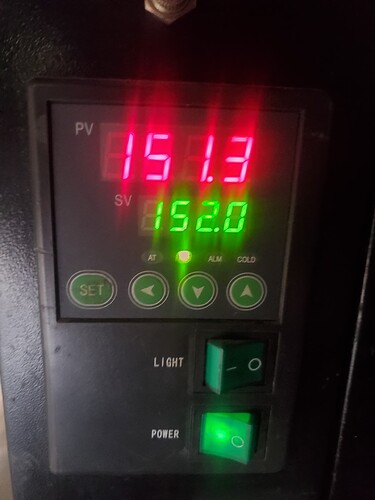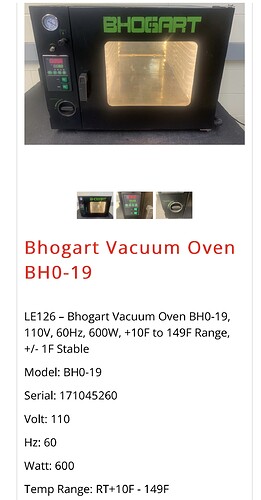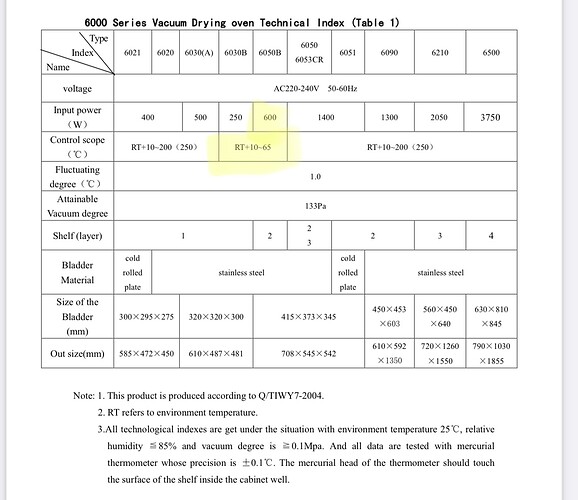Anyone know how I can raise rhe max temp on a bhogart vac oven? It’s max temp is set to 152 F
What PID is being used?
Pic
The SV is locked at 152?
Yes both bhogarts I have are maxed at 152
Will it go lower than 152?
Some controllers are only rated to a certain high end temp… some of my CHB series controllers only go to 100c, some to 150c, and some up to 400c depending on the model.
If you can get a look at the model and full SN etc you should be able to figure out what it’s rated to.
Yea it will go to any temp lower not an issue
Really need to see the tags behind the panel itself to get model info. Doesn’t say any info on front that could help figure out range limitations.
Some controllers let you go into a settings screen to expand the temp max/mins.
Looks like that is indeed the max operating temp.
You can see the oven in the picture is also displaying 152 for the SV.
I found a manual for another oven with a similar PID and the values seem to match.
How many watts does yours state @TRIPPIE
That’s the real determinating factor in max temp.
You can get a $20 PID controller on amazon and rewire it to get as hot as you wish. But you may burn the heater elements if it’s undersized.
His oven is 600W, which is why it’s displaying 152 for the max temp with that controller.
That’s actually kinda cool, I just thought all 1.9 cu ft ovens were 1.5kw, but being able to get them where they only consume half that much power could be pretty handy in a space with limited power. The only catch being they probably take longer to heat up too I’d imagine.
Yeah but most operations keep ovens on 24/7 and they just have to maintain heat 90% of the time. There isnt much heat loss in oven as were not really actively recovering solvent at a boil causing evaporative cooling.
I wonder how much energy is being stolen by 6 full trays of slightly wet shatter pours? Probably not enough that 600 watts couldn’t keep up with it, but that’d be a hell of a calculation.
As we know Vacuum Drying Oven:1.9CF 110V 50/60Hz 1Ph.
Heating Tube (Designed) Heat to 100C (max) or 220c (max,because gasket can not resist long time)
Thus we adopt Japanese Fuji PID controller with precision control on temp.
152F=66.6c its not reaching 100c.
That’s interesting information too. I wonder if the gaskets being used on the various oven options are being carefully selected to withstand the maximum operating temperatures.
@CEMAINSTRUMENT I’m not sure what you’re getting at though honestly aside from the fact that it’s maximum set operating temperature is below what the pid is designed to reach, which seems like a nice additional safety measure to me and fits within the temperature range needed for post processing by most cannabis processors.
Our 16CF Vacuum Oven Come install with Over-Heat Temp Protect Safety Device.
1.9CF andd3.4CF 7.8Plus come with low watt and save cost on electricity and precision temp control.
Cema Instrument
My bhogarts and across ovens averaged about 3-400 watts once running and warm when i was all of grid
It’s actually not that crazy of a calculation, just a bunch of algebra.
Total Heat Lost = Sensible Heat Change + Latent Heat Change
Sensible Heat is the heat required to change the temperature of a substance
Latent Heat is the heat required to cause a phase change
Sensible Heat (q) = Heat Capacity (c) x Mass (m) x Temperature Change (dT)
Latent Heat (q) = Mass (m) x Heat of Vaporization (Hv)
Total Energy Lost = (c * m * dT) + (m * Hv)
Assuming we’re using pure n-Butane:
c = 1.675 J/g*K
Hv = 386 J/g
Also making some other assumptions about conditions (10 degree temperature change):
dT = 10 deg K
Energy Loss per gram of Butane left in extract = 402.75 J/g
Now since watts is energy over time (Joules per second to be exact), we have to account for the amount of time this process takes. Assuming your purge cycle takes an hour (may be a bad assumption, idk I don’t run a lab):
Watts needed per gram of Butane left in your slabs = 0.112 W/g
Disclaimer: This does not account for how heat of vaporization and heat capacity change with temperature and pressure. Also this is a little backwards because we’re assuming time is fixed. Typically it’s the other way around (your conditions determine how fast it goes, not time determining your conditions).
Thank you for coming to my Ted Talk ![]()




